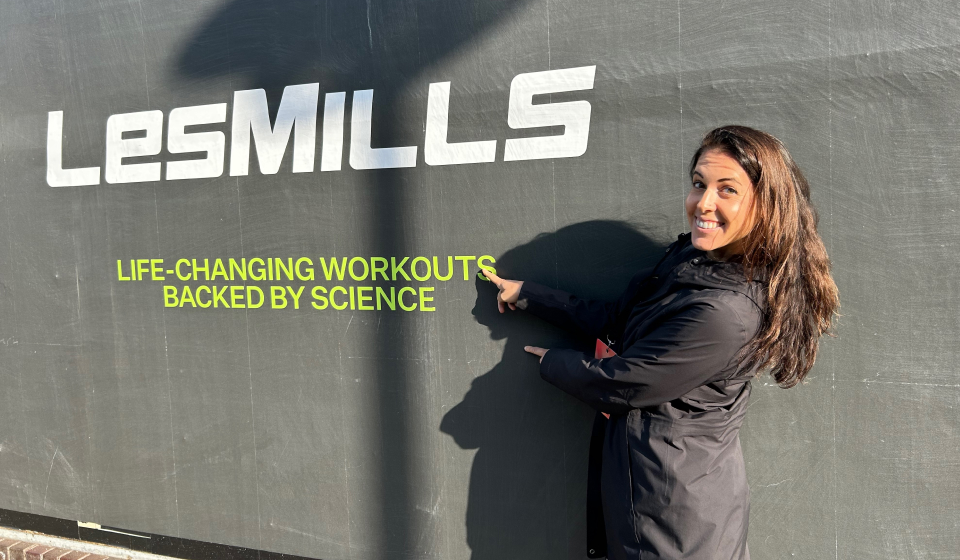Jon: What have your journeys been?
Dr Gottschall: I started taking Les Mills classes as a graduate student in biomechanics and physiology, using BODYPUMP™ as cross-training for triathlons. Over time, I became more aware of participants' technique and grew concerned about the biomechanical safety of forward lunges.
As an Instructor, Master Trainer Sheldon McBee encouraged me to share my concerns with Bryce Hastings, Les Mills Head of Research, who, along with Jackie, appreciated the data showing the superiority of backward lunges. That connection sparked our collaboration, and my first official project was helping to develop LES MILLS CORE™!
Dr Hatfield: My research focuses on biomechanics in clinical populations, particularly muscle activation patterns in people with knee osteoarthritis and lower back pain. Past studies I contributed to found differences in abdominal and back muscle activity between those who recovered from lower back pain and those who never experienced it. I planned a study on whether exercise could modify these patterns to reduce recurrence risk, using LES MILLS CORE, which had helped my own chronic back pain. I reached out to Bryce in 2019, and that marked the beginning!

Jon: How would you describe your role within Les Mills over the past few years?
Dr Hatfield: In addition to the research I’ve done looking at the benefits of various programs, such as LES MILLS CORE, BODYBALANCE™, and LES MILLS TONE™ in different populations, such as people with lower back pain, postpartum women, and university students, I’m involved in testing efficacy of new programs. New programs are first trialled in Les Mills gyms in New Zealand where there might be changes based on feedback from the creative team.
Next, it goes for efficacy testing - does this program do what we intend for it to do? For example, as a result of the testing for LES MILLS SHAPES™, I found doing the workouts three times per week for 6 weeks improved dynamic balance, abdominal muscle endurance and back muscle endurance. Last year I did the efficacy testing for LES MILLS PILATES™.

Efficacy testing means we can be confident in the benefits of these programs when they are launched internationally.
Now I have joined the technical team, I am also involved in signing off new releases of BODYATTACK™, BODYSTEP™, and BODYBALANCE programs each quarter, making sure choreography is safe and targeting the intended muscles. I work with the Masterclass presenters during rehearsals, making sure what they say is scientifically accurate, mandatory safety cues are given, and the execution of moves is perfect.
Dr Gottschall: My specialties within Les Mills relate to high intensity (GRIT™ and LES MILLS SPRINT™) as well as LES MILLS CORE and all cycling (RPM™, LES MILLS SPRINT, THE TRIP™).
“I will do BODYPUMP for the rest of my life at least 2 times per week.”
I also assist with projects outside of the programming such as ideal timing of squats, core activation during BODYCOMBAT™, the group effect (including differences between Live and Virtual), healthy blood glucose variability, cyclic training, and BORN TO MOVE™.
Similar to Gillian, I review the quarterly releases for all cycling (RPM, SPRINT, THE TRIP). In this new role, I help incorporate the most recent scientific research findings into the programs by communicating with presenters and, when appropriate, adding small tips into the coaching for the Masterclasses.

Jon: The Les Mills focus on science is unique. What does this mean for Instructors?
Dr Hatfield: Bryce Hastings likes to say: “We obsess about the details so you don’t have to.” I believe Les Mills separates itself by spending the time, energy, effort, and funding to ensure all its programs meet the highest standard of performance and safety while maximizing adherence, through science and data. Brilliant and impressive!
Dr Gottschall: In addition to Gillian’s point, the research team meets each month to talk about the latest sports science research and how we can bring that into our programs. Every quarter, Instructors get choreography that is backed by the latest scientific research in exercise physiology and biomechanics.
Jon: Are the positive clinical outcomes of group training taken seriously enough by the medical profession?
Dr Hatfield: I would say the clinical benefits of group training are taken seriously. Research shows that group-based exercise interventions improve adherence and maximize resources, but they’re typically delivered in healthcare settings like hospitals. What’s often overlooked is the clinical value of group training in fitness facilities.
I’d love to see gym memberships covered by insurance or patients being prescribed Les Mills programs for medical conditions. For example, we have evidence supporting LES MILLS CORE for managing lower back pain, and we're currently researching the effects of LES MILLS THRIVE™ on older adults with hip or knee osteoarthritis.
“I have made some of my best friendships through teaching Les Mills programs. I have been teaching at my current gym for over 10 years, and many participants have been in my classes for that same length of time.”
Jon: Have you found any surprising results in your research?
Dr Gottschall: A 50-minute BODYCOMBAT class yields core activation similar to performing 1,700 crunches!
Dr Hatfield: This might not be surprising to avid Pilates participants, but I was surprised by the 20% increase in hamstrings flexibility we saw with an 8-week intervention of LES MILLS PILATES in people who were already physically active.
Want to learn more?
On your Les Mills Releases App, head to 'Tips' and scroll down to 'Research.' Here, you'll find a collection of fascinating videos that summarize the team’s latest findings. For example, the latest research video on the app is about the benefits of LES MILLS CORE for people with lower back pain – a condition that affects many of us and could be a great recommendation for some of your Movers!
Jon: How do you ensure each workout is suitable for both beginners and regulars?
Dr Gottschall: The key is options – allowing participants to get the ideal workout for them at that current moment.
Dr Hatfield: Indeed. Even if you’re a frequent gym-goer, not every day is the same in terms of the intensity you can bring to a workout. Some days you might have had a poor night’s sleep, or be recovering from illness or injury, or smashed a really intense workout on the previous day. We give lots of options to increase or decrease intensity of each move to give participants autonomy in their workouts.
Jon: What upcoming research projects are you most excited about?
Dr Hatfield: I am most excited about LES MILLS THRIVE and its potential effect on muscle activation patterns in people with knee osteoarthritis. Previous research I’ve done has found that elevated and prolonged muscle activity during walking in people with knee osteoarthritis is associated with a faster progression of the disease. We think this muscle activity might be a compensation to increase knee stability. This study is going to see if LES MILLS THRIVE can result in positive changes in these patterns of muscle activity.
Dr Gottschall: I second Gillian’s answer on LES MILLS THRIVE. She and Bryce will be directly involved in recruitment and data collection – the potential for this program to benefit a special population is thrilling!

Jon: How do you both relax?
Dr Gottschall: Hiking with my dogs and BODYBALANCE flexibility are my ideal activities for relaxation!
Dr Hatfield: I took up stand-up paddleboarding a couple of years ago, so I love to do that in the summer. I also really love to golf, when I can find the time!
Jon: In one word, what do Les Mills Instructors bring to Movers?
Dr Gottschall: Expertise!
Dr Hatfield: Passion! I have never seen a group of such committed, passionate Instructors.








